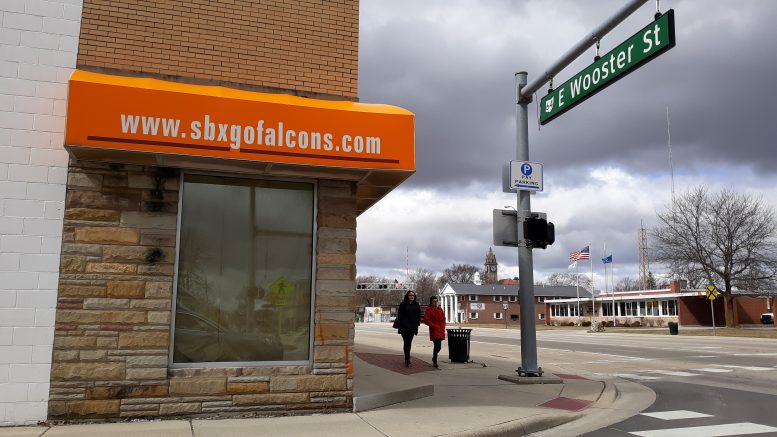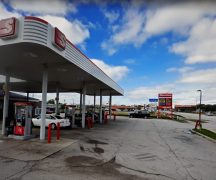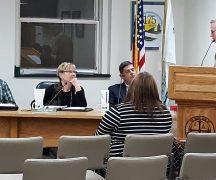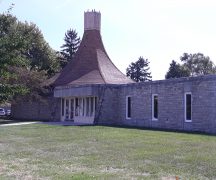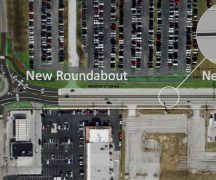By JAN LARSON McLAUGHLIN
BG Independent News
“Ground zero” has been identified for Bowling Green’s East Wooster Street development efforts.
After three strategic plans over five years, the intersection of East Wooster with Thurstin and Manville streets appears to be the best place to kickstart the city’s transformation.
“We have studied enough and it’s time to implement the citizens’ priorities,” said Bowling Green City Council member Greg Robinette, who led council’s meeting of the Planning, Zoning and Economic Development Committee Monday evening.
“We’re not going to be able to do everything,” Robinette said, suggesting the committee chose wisely how to proceed.
The committee is charged with deciding which development recommendations to make to council for the city’s “front door” along East Wooster Street. After City Council reviews the priorities, they will be sent back to the committee, which will then decide how they can be implemented.
“I appreciate that you keep pushing on this,” council member Bruce Jeffers said to Robinette, acknowledging that some in the community think the city studies issues too long before taking action.
But Jeffers defended the need to carefully pick a plan the city can stick with, rather than lurching from one way to another.
“We’re doing the right thing,” he said. “We need a little push to keep things moving.”
Council member Sandy Rowland signaled her readiness to kick the effort into gear.
“We are ready. The study has been done,” she said, thanking Mayor Dick Edwards for his pushing of the subject.
“I’m up for it. I think this committee is up for it, and council is up for it,” Rowland said.
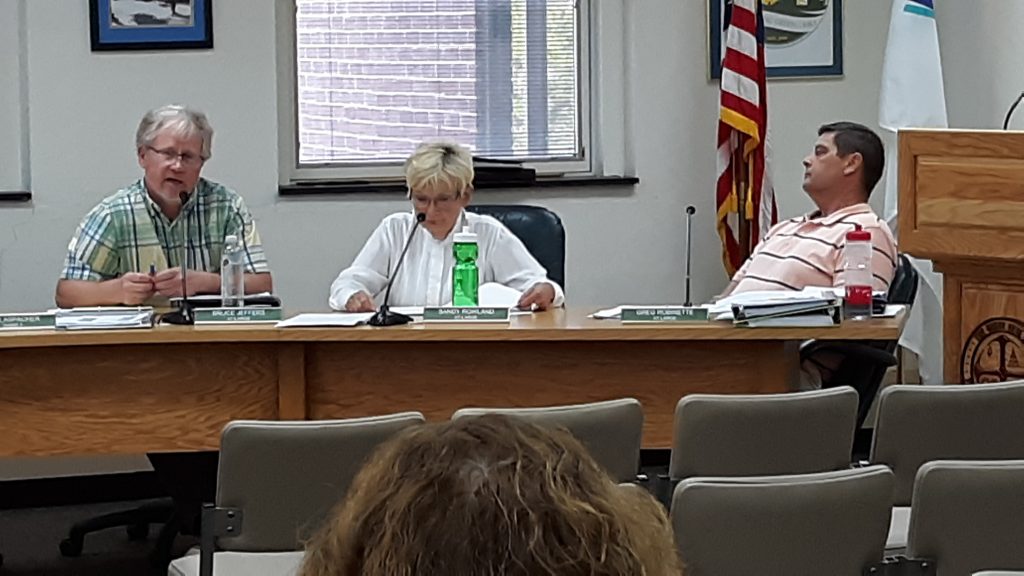
Robinette will present the priorities at the next council meeting. Some of the goals discussed Monday evening included:
- Pave the way for a pivotal development at the “ground zero” of the four corners where the university ends and the link to the downtown begins. That may mean the city moving its electric division building located now near the northwest corner of East Wooster and Thurstin streets.
- Look for one pivotal, transformational project that can jumpstart development all along East Wooster Street.
- Improve housing in the city. “We’re thinking if we improve the housing that will entice people to move here,” Jeffers said. And development will follow.
- Focus on improving the quality of life offered in Bowling Green – which is one of the main factors people move to a community, Robinette said. “We are absolutely losing too many great minds who are graduating from BGSU,” Rowland said, adding that she is tired of seeing people leave for Perrysburg to buy homes and raise children.
- Focus on high-quality student housing. “If we can create a number of good quality housing areas, that will take a lot of pressure off of older housing that is subdivided now,” Jeffers said. That housing may then revert back to single-family homes.
- Update the city’s zoning regulations to allow for more creative projects.
- Make way for mixed use properties, Rowland said, with businesses like a deli on the first floor with student housing on the second and third floors – again taking the pressure off older housing being subdivided for students.
- Infuse public art along East Wooster Street. “I think as council, we should encourage that,” Rowland said.
- Encourage the use of old gas stations for local businesses, such as food trucks. “We need to have our eyes and ears open for what businesses are telling us,” Rowland said.
- Create ongoing communication specifically about the development plans with BGSU and Wood County Hospital, which are both vital to the success of East Wooster changes.
“I think we’ve got a good start here,” Robinette said.
City Council President Mike Aspacher agreed with the committee that the study period was over.
“We have reached the time for action,” Aspacher said. “All of us are eager for action. I think all of us agree, it’s time to go.”
The latest study, conducted by Development Strategies of St. Louis, pulled no punches as it pointed out where the city has gone wrong, and where it needs to change course to avoid a downward spiral.
The university and historic downtown are definite draws for the community, the study stated. But East Wooster Street – the front porch of the community – is littered with “haphazard development and poor quality buildings.”
The study concluded that it’s not enough that the city has made minor changes to the zoning code, and that BGSU has purchased of some lots and demolished of some eyesores on East Wooster Street.
To compete with other communities, especially other university towns, the city and BGSU need to take some control to promote healthy development along East Wooster.
The report has an “unmistakable sense of urgency,” Edwards has said.
Following are some conclusions and recommendations from the study:
First impressions really count
Bowling Green is a far more impressive community than its first impression indicates. It has two major assets that many communities would be envious of: a public university and a charming, historic downtown.
Even so, the main corridor that welcomes visitors to the city and connects these destinations gives a negative impression that is hard to overcome. The investments BGSU has made in the Stroh Center and Falcon Health Center set a new standard for quality; however, both public and private investment will be needed to infuse the 1.8-mile corridor with vitality.
Behind in economic development trends
The national economy is changing, but Bowling Green has not adapted its approach to economic development. The city’s efforts in regards to industrial/manufacturing jobs have proven fruitful, but this singular focus has come at the expense of knowledge-based industries that are growing and are expected to become increasingly important in the future.
This blue-collar focus needs to be balanced with a broader vision of growth that will lead to greater prosperity in the long-term, and this is going to require a new strategic direction that is supported by all members of the community.
People are searching for quality of life
People are increasingly choosing where they want to live based on the quality of life. Therefore, the quality of place (amenities, public space, walkability, etc.) is becoming a critical component in attracting and retaining the next generation of people who will call a community home.
At least two major institutions, BGSU and Wood County Hospital, have clearly stated that the quality of the city, and the state of Wooster Street in particular, are negatively affecting their ability to attract talent. Potential employees don’t see the amenities they desire and find it easier to go elsewhere.
Top students and their parents come to the community and don’t see it as a fun, progressive place they want to spend the next four or more years in. Bowling Green has a major image problem that needs to be fixed.
There’s no time to wait …
Bowling Green needs to make large strides in quality of place, or risk declining enrollment for its biggest employer. The number of college bound students is likely to decline substantially starting in the year 2025.
Officials at BGSU are keenly aware of the challenge before them. Attracting students is going to be increasingly competitive, and students are choosing where to attend based not only on the quality of the campus and educational programs, but increasingly based on the quality of the community where the school is located.
BGSU is going head to head with institutions in cities that offer a much higher quality of place than Bowling Green – ones that have facilitated redevelopment in their downtowns, invested in the quality of their streets, feature high quality amenities and restaurants, host numerous community events, and exude charm and character.
The condition of the city puts BGSU at a competitive disadvantage and negatively affects the ability of the university to attract students.
City’s ‘hands-off’ approach is not working
The “hands off” approach to redevelopment must end—the types of projects the community desires and needs will not happen on their own. The economics of quality development are extremely challenged in Bowling Green, making it all the more important that the city and BGSU work together.
Robust incentives such as TIF and tax abatement will be essential and property assembly may be necessary. If these efforts are not undertaken, the next student housing project will follow the path of least resistance and happen on “easy” greenfield properties like the former Harshman site, or even worse, on the periphery of the city.
These greenfield sites are easier to develop than the alternative, but will not be as catalytic as they will do nothing to remove the undesirable buildings that are detracting from the community and hampering economic development.
If greenfield student housing development occurs, the likelihood of the community being able to support another large upscale student housing project is greatly diminished and the opportunity for a transformational project will evaporate.
The power of one transformational project should not be underestimated; undertaking the first big project can build momentum and set the tone for the rest of what is to come.
What type of development will work?
While more student housing may not appear to be the first choice of the community right now, the fact remains that it is one of the only types of products that is currently profitable enough to withstand the costly redevelopment involved along the Wooster corridor.
Additional public outreach is desperately needed to help the community understand these development feasibility issues. Community fears can be lessened by education on how increased density and architectural controls can be used in tandem to produce buildings that will be a source of pride for the city.
It is also important to help the community understand the “long game.” Once a cycle of investment occurs (a few successful projects, streetscape improvements, etc.), market demand for other products will increase as the area becomes more desirable and higher rents can be achieved.
So the young professional housing, mixed-use retail, and boutique hotels that are not possible now, may very well be possible in the future. But Bowling Green needs to take the first step and use the opportunities available now to ensure that more opportunities will be available later.
Creating a community of quality and charm
Bowling Green has an opportunity to create a distinctive place by building upon its core assets and rigorously working to improve the elements that detract from its charm.
Investments in the quality of place (amenities, streetscapes, art and events) will pay dividends in the future. These improvements will help attract the next generation of residents who will call this city home.
These same investments can be used to appeal to tourists, whose purchasing power can be used to help smooth out the slow summer months that deter many businesses from entering the Bowling Green market. These efforts will create a virtuous cycle, expanding the local economy and creating more opportunities for growth and future redevelopment.

